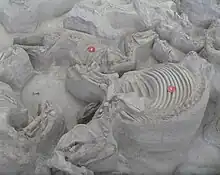Cormohipparion
Cormohipparion is an extinct genus of horse belonging to the tribe Hipparionini that lived in North America during the late Miocene to Pliocene (Hemphillian to Blancan in the NALMA classification).[1] This ancient species of horse grew up to 3 feet (0.91 meters) long.[2][3]
| Cormohipparion | |
|---|---|
 | |
| Cormohipparion and Teleoceras in the Ashfall Fossil Beds | |
| Scientific classification | |
| Domain: | Eukaryota |
| Kingdom: | Animalia |
| Phylum: | Chordata |
| Class: | Mammalia |
| Order: | Perissodactyla |
| Family: | Equidae |
| Subfamily: | Equinae |
| Tribe: | †Hipparionini |
| Genus: | †Cormohipparion Skinner & MacFadden, 1977 |
| Type species | |
| †Hipparion occidentale | |
| Subgenera and species | |
|
†Cormohipparion
†Notiocradohipparion
| |
Taxonomy

The genus Cormohipparion was coined for the extinct hipparionin horse "Equus" occidentale, described by Joseph Leidy in 1856.[4] However it was soon argued that the partial material fell within the range of morphological variation seen in Hipparion, and that the members of Cormohipparion belonged instead within Hipparion.[5][6] This rested on claims that pre-orbital morphology did not have any taxonomic significance, a claim that detailed study of quarry sections later showed to be false.[7] The genus was originally identified by a closed off preorbital fossa, but later examinations of the cheek teeth, specifically the lower cheek teeth, of Cormohipparion specimens found that they were indeed valid and distinct from Hipparion.[8] A reappraisal of many horse genera was thus conducted in 1984,[9] and the proposed synonymy was not acknowledged by later literature.[10] C. ingenuum holds the distinction for being the first prehistoric horse to be described in Florida, as well as being one of the most common species of extinct species three-toed horses found to be in Florida.[11] Cormohipparion emsliei has the distinction of being the last hipparion horse known from the fossil record.[12]
The genus is considered to represent an ancestor to Hippotherium.[13] Its fossils have been recovered from as far south as Mexico.[14] Fossils have been found in the Great Plains and Rio Grande regions of North America, Mexico, Florida and Texas, which shows that they were herding animals.[15][16][17][18]
References
- MacFadden, Bruce J.; Skinner, Morris F. (1982). "Hipparion Horses and Modern Phylogenetic Interpretation: Comments on Forsten's View of Cormohipparion". Journal of Paleontology. 56 (6): 1336–1342. ISSN 0022-3360. JSTOR 1304670.
- "Region 4: The Great Plains". geology.teacherfriendlyguide.org. Retrieved 2021-06-23.
- Oklahoma Geology (PDF). Vol. 61, no. 3. Fall 2001 http://ogs.ou.edu/docs/geologynotes/GN-V61N3.pdf.
{{cite magazine}}: Missing or empty|title=(help) - Skinner, M. F.; MacFadden, B. J. (1977). "Cormohipparion n. gen. (Mammalia, Equidae) from the North American Miocene (Barstovian-Clarendonian)". Journal of Paleontology. Paleontological Society. 51 (5): 912–926. JSTOR 1303763.
- Forsten, A. (1982). "The Status of the Genus Cormohipparion Skinner and MacFadden (Mammalia, Equidae)". Journal of Paleontology. Paleontological Society. 56 (6): 1332–1335. JSTOR 1304669.
- MacFadden, Bruce J. (1985). "Patterns of Phylogeny and Rates of Evolution in Fossil Horses: Hipparions from the Miocene and Pliocene of North America". Paleobiology. 11 (3): 245–257. Bibcode:1985Pbio...11..245M. doi:10.1017/S009483730001157X. ISSN 0094-8373. JSTOR 2400665. S2CID 89569817.
- MacFadden, B. J.; Skinner, M. F. (1982). "Hipparion Horses and Modern Phylogenetic Interpretation_ Comments on Forsten's View of Cormohipparion". Journal of Paleontology. Paleontological Society. 56 (6): 1336–1342. JSTOR 1304670.
- Forsten, Ann (1982). "The Status of the Genus Cormohipparion Skinner and MacFadden (Mammalia, Equidae)". Journal of Paleontology. 56 (6): 1332–1335. ISSN 0022-3360. JSTOR 1304669.
- MacFadden, BJ (1984). "Systematics and phylogeny of Hipparion, Neohipparion, Nannippus, and Cormohipparion (Mammalia, Equidae) from the Miocene and Pliocene of the new world". American Museum of Natural History.
- Hulbert Jr, R. C. (1988). "A New Cormohipparion (Mammalia, Equidae) from the Pliocene (Latest Hemphillian and Blancan) of Florida". Journal of Vertebrate Paleontology. The Society of Vertebrate Paleontology. 7 (4): 451–468. Bibcode:1988JVPal...7..451H. doi:10.1080/02724634.1988.10011675. JSTOR 4523166.
- "Cormohipparion ingenuum". Florida Museum. 2017-03-30. Retrieved 2021-06-16.
- "Neohipparion". Florida Museum. 2018-02-16. Retrieved 2021-06-26.
- Woodburne, M. O. (2005). "A New Occurrence of Cormohipparion, with Implications for the Old World Hippotherium Datum". Journal of Vertebrate Paleontology. 25: 256–257. doi:10.1671/0272-4634(2005)025[0256:ANOOCW]2.0.CO;2. ISSN 0272-4634. S2CID 86241044.
- Bravo-Cuevas, V. M.; Ferrusquía-Villafranca, I. (2008). "Cormohipparion (Mammalia, Perissodactyla, Equidae) from the Middle Miocene of Oaxaca, Southeastern Mexico". Journal of Vertebrate Paleontology. 28: 243–250. doi:10.1671/0272-4634(2008)28[243:CMPEFT]2.0.CO;2. ISSN 0272-4634. S2CID 131613568.
- Skinner, Morris F.; MacFadden, Bruce J. (1977). "Cormohipparion n. gen. (Mammalia, Equidae) from the North American Miocene (Barstovian-Clarendonian)". Journal of Paleontology. 51 (5): 912–926. ISSN 0022-3360. JSTOR 1303763.
- Bravo-Cuevas, Victor Manuel; Ferrusquía-Villafranca, Ismael (2008). "Cormohipparion (Mammalia, Perissodactyla, Equidae) from the Middle Miocene of Oaxaca, Southeastern Mexico". Journal of Vertebrate Paleontology. 28 (1): 243–250. doi:10.1671/0272-4634(2008)28[243:CMPEFT]2.0.CO;2. ISSN 0272-4634. JSTOR 30126348. S2CID 131613568.
- Hulbert, Richard C. (1988). "A New Cormohipparion (Mammalia, Equidae) from the Pliocene (Latest Hemphillian and Blancan) of Florida". Journal of Vertebrate Paleontology. 7 (4): 451–468. Bibcode:1988JVPal...7..451H. doi:10.1080/02724634.1988.10011675. ISSN 0272-4634. JSTOR 4523166.
- MacFadden, Bruce J.; Skinner, Morris F. (1981). "Earliest Holarctic Hipparion, Cormohipparion goorisi n. sp. (Mammalia, Equidae), from the Barstovian (Medial Miocene) Texas Gulf Coastal Plain". Journal of Paleontology. 55 (3): 619–627. ISSN 0022-3360. JSTOR 1304276.